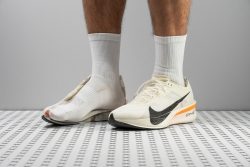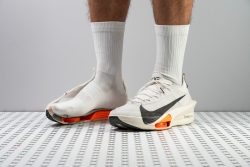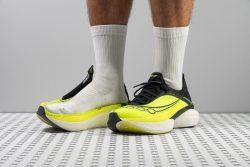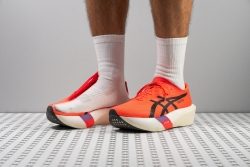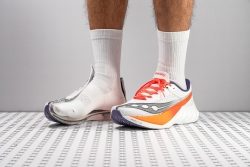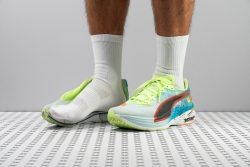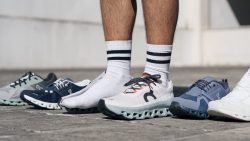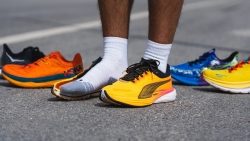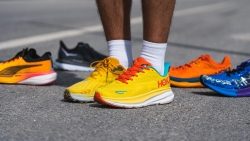7 Best Competition Running Shoes in 2025

We buy shoes ourselves. We earn commissions when you buy through us, at no extra cost. Why trust us
With speed written all over them, the best running shoes for racing are light, aggressive, and crazy responsive. With so many competition running shoes to choose from, it can be a challenge to pick the right pair - let alone the best pair.
But don’t fret; we have tested competition running shoes one by one just to have the answer to which one is the best for you. We ran in them and we tested them in our lab. We also went down the rabbit hole explaining which features to look for in race shoes and what you should prioritise.
Race shoes that truly impressed us and stood out from the rest are highlighted here as top picks.
How we test competition running shoes
To ensure the objectivity of our reviews, we do the following:
- Buy race shoes using our own money. Every cent invested comes from our pockets.
- We hit the streets in these shoes and do test runs in them. We do lots of test runs with each pair before we log our observations.
- Bring the shoes to our lab. We cut the race shoes in half and measure different parameters using our tools and equipment. We publish 20+ data points on each shoe, including their energy return, shock absorption, breathability, stiffness, outsole thickness and hardness, weight, and so on.
Best competition running shoes overall
























































What makes it the best?
We flew to the finish line with this insanely responsive, lightweight, and surprisingly comfortable shoe. It has all the speed-enhancing features that justify its £260 price tag. With its unmatched energy and performance, Vaporfly 4 works best for PR chasers, making it our ultimate pick for competition running.
Our lab results speak for its speed, yet our feet lived to tell the tale. Its ZoomX foam felt incredibly springy and soft, like launching off a diveboard in every toeoff and landing home with its cosy platform. Our durometer confirms its gentle touch at 19.9 HA.
This racer could keep up even if we pushed our paces to the limit. It felt more natural to run at faster speeds! Our bend test confirmed this and showed it's 14.6% stiffer than average! Keeping each turnover effortless and efficient is the shoe’s carbon Flyplate and light weight. At 5.9 oz (166g), it’s much lighter than the average racer (7.3 oz / 208g).
Complementing the performance-driven midsole is a well-ventilated upper that scored a high 4/5 on our breathability test. There’s no need to worry about overheating or getting blisters in this pair.
We discovered that VF4 performs best in distances up to a half-marathon. Because of its reduced stack, it may lack the cushioning marathoners seek, especially towards the final miles.
Pros
- 13% lighter than the Vaporfly 3
- Awesome for 5K, 10K and 21K races
- Full ZoomX midsole
- Spring-loaded carbon-fibre Flyplate
- Fantastic lockdown with premium laces
- Moderate rocker for a more natural ride
- Improved perforated, removable insole
- Better rubber coverage in the forefoot
- Gets improvements from the Alphafly 3
- Great upper featuring breathability and durability
Cons
- Less ideal for marathon racing
- Still lacks the snappy feel of the Vaporfly 1&2
- Narrow midfoot and heel limit stability
Best competition running shoes for marathon
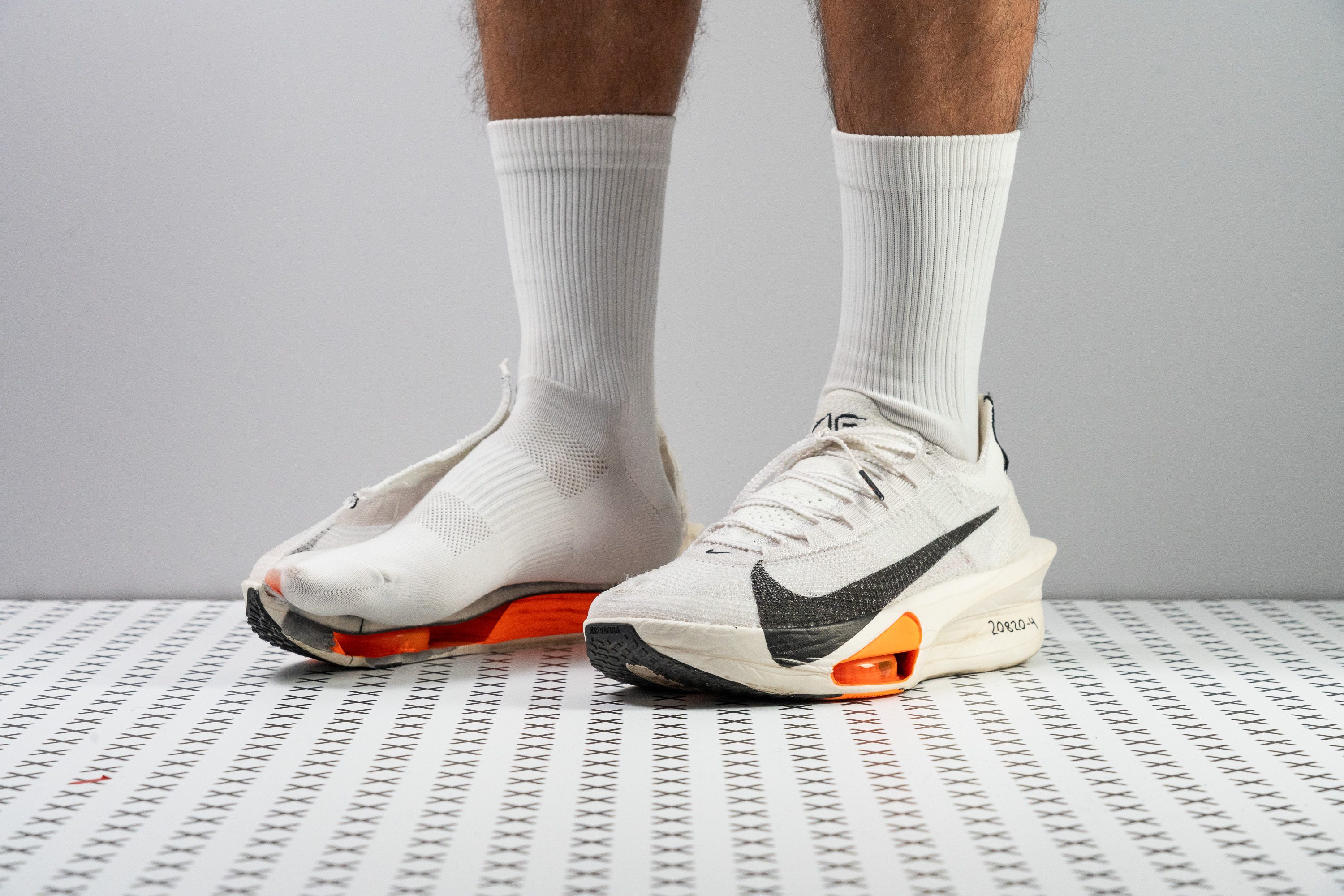













































































What makes it the best?
The third iteration of Alphafly is a super shoe marvel with its overwhelming energy return, cushioned platform, and unexpected stability. After hours in the lab and miles on foot, it's our top marathon/ultra-shoe, which provides heavenly comfort, extra support, and tonnes of energy for endurance runs.
This racer comes to life and feels more natural at faster paces. Our cut-in-half shoe reveals the rigid FlyPlate and Air Pods integrated into the midsole. These provide a consistent stream of energy that shines in longer distances. Our 90° bend test reveals a solid 144.7% higher stiffness than average.
Alphafly 3 features the dynamic ZoomX midsole that offers world-class responsiveness. What sets this shoe apart is its dual-density setup. Our durometer shows the top layer is 23.6% firmer than average to enhance stability and control, while the bottom layer is 23.3% softer than average for impact protection. Both elements work together to save our legs from fatigue, especially in the latter miles when extra support is needed.
Despite the sky-high stack, the shoe is surprisingly light (7.1 oz / 201g). What also amazed us was the immensely breathable Atomknit upper that assures we won't have hotspots or blisters.
The outsole may be less resistant to abrasions since the rubber is 1.3 mm thinner than average. We recommend saving this shoe for race days.
Pros
- Remarkably lightweight despite its broad size
- Best-in-class breathability
- Excels in the marathon distance
- Repositioned Air Pods offer a better ride than the v2
- ZoomX foam delivers massive energy return
- Aids in forward momentum, especially when legs begin to fatigue
- Better than ever for 5K/10K racing
- Finally smooth transitions!
Cons
- Heel strikers might wear down the outsole quickly
- The arch could still be a challenge for some
- The sock-like tongue might not suit everyone
Competition running shoes with the best energy return






























































What makes it the best?
We found a light race shoe that's not only responsive but also has a stellar outsole! Say hola to the Adizero Adios Pro 4. It has an outsole that's durable enough, and a dynamic midsole that’s cushioned and responsive enough for long-distance races—proving it offers the best energy return among race shoes we lab-tested.
This shoe provides a snappy ride through its delightful cushion and carbon-infused rods that mimic our foot anatomy. Each toe-off feels energised because the Energy Rods 2.0 added the right amount of stiffness. Testing for energy return, the forefoot impressed with a massive 80.3%, which really makes a difference compared to the 60.5% average.
With every landing, a gentle soul meets our feet. The luscious stack feels very plush and took the load of impact off our legs, confirmed by above-average shock absorption scores of 142/117 SA in the heel and forefoot.
Though a softer and thinner outsole—only 41.0 HC and 1.0 mm, respectively—means less durability, that’s not the case with AP4! We barely scratched the outsole after miles of running, and our Dremel test results agree. The thinner outsole also enhanced the plushness of the midsole and brought the shoe’s weight down to only 7.1 oz (200g).
Unfortunately, its tapered toebox may cause pressure points to those with wide or swollen feet. Those looking for an accommodating fit should skip this pair.
Pros
- Softer, bouncier Lightstrike Pro foam
- Maintains the same price
- No more heel slippage
- Versatile from 5K to marathon distances
- Durable outsole with outstanding grip
- Fantastic for midfoot and forefoot strikers
- Improved for faster runners
- Comfortable, gusseted tongue
- Lighter than Adios Pro 3
Cons
- Unstable for every heel striker
- Narrow, tapered toebox
- Upper lacks breathability
- Midsole loses bounce quicker than AP3
Competition running shoes with the best shock absorption
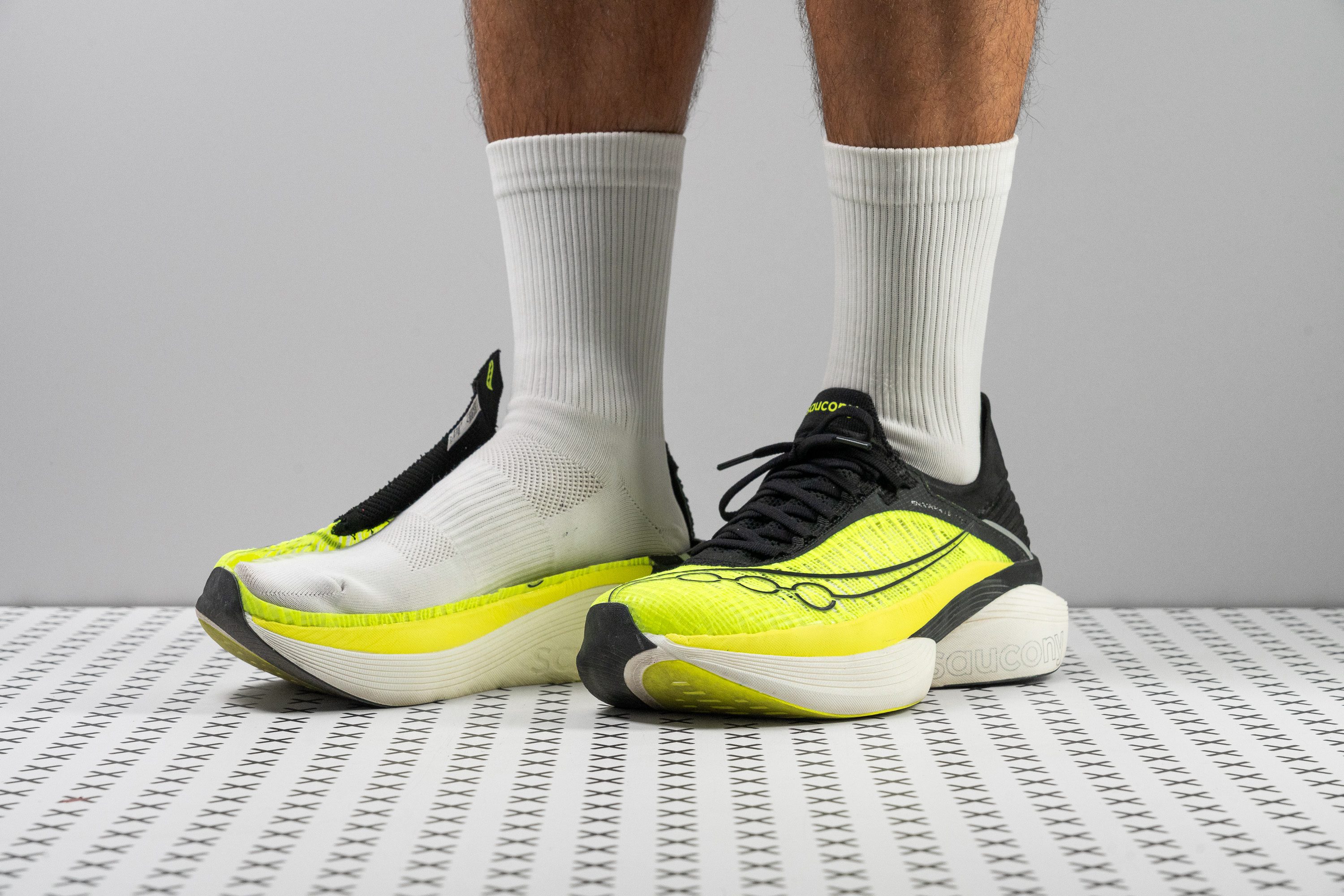















































What makes it the best?
The Saucony Endorphin Elite 2 is a dream for racers in need of maximum shock absorption. The lab results blew us away, but it’s our feet that truly enjoyed the magic of this supershoe. From its protective and responsive midsole to its light build, EE2 feels so good on foot!
The midsole packs a lot of cushioning into it, verified by our calliper with 39.9/32.4 mm measurements. This ensures elite impact protection, and our shock absorption test confirms its leg-saving properties with elite scores of 157 SA in the heel and 123 SA in the forefoot. No wonder our legs don’t feel sore even after a hard run.
With every gentle landing, a springy rebound awaits. Lab results show the IncrediRUN foam delivers with top energy return scores of 80.6% in the heel and 82.1% in the forefoot. On top of that, the spoon-shaped carbon plate adds responsiveness without stiffening the shoe too much.
EE2 demands going full throttle. Sitting at a light 6.9 oz (197g), it requires less effort to lift each foot, keeping our momentum strong.
However, its lack of support can be risky for runners who require even mild stability. We can only recommend this pair to runners with consistent and precise form.
Pros
- Record-breaking energy return
- Ultra-plush foam
- Fantastic shock absorption
- Addictively bouncy and fun feel
- Ideal for the marathon distance
- Durable and breathable upper
- Improved lockdown with knit tongue
- Stack height maxes out the legal limit
- Explosive, forward-driving ride
Cons
- A touch heavy for being an elite supershoe
- Budget-crushing price
- Lateral stability is extremely bad
- Lacks specific support for heel strikers
Best lightweight competition running shoes




















































What makes it the best?
Honouring the Metaspeed Edge Tokyo’s moniker, this ASICS model is all about speed! It offers a superior combination of boundless energy and a cushy platform in a feathery, breathable package—a solid choice for competitive runners seeking the best lightweight option.
This shoe is meant for racing. At 5.6 oz (59g), it’s 23.2% lighter than the average competition shoe in our roster. Our feet felt the lightest and the freshest with this pair, confirmed by its perfect score on our breathability test.
We found ourselves running faster with less effort in this pair. Every time we land our foot, the curved carbon plate and bouncy FF Leap foam springs us back up—encouraging high cadence and efficient turnover. Our lab results speak for this, with massive energy return scores of 78.3% (heel) and 76.8% (forefoot).
With every stride, a delightful platform awaits. At a sky-high 38.9/32.0 mm, we won’t run out of comfort until the last mile. The midsole continues to impress with world-class shock absorption scores of 146 SA (heel) and 132 SA (forefoot).
Beware of this shoe’s outsole since it has lots of exposed foam. With its minimal rubber coverage, it's more vulnerable to abrasions.
Pros
- Light as a feather
- Excels at any distance, from 5K to the marathon
- Elite-level traction
- New FF Leap midsole is super responsive
- More stable than the Metaspeed Sky Tokyo
- Plush forefoot
- Excellent upper
- Classic rolling feel from curved plate
- Better than Metaspeed Edge Paris in every way
Cons
- Price increase
- Narrow fit
- Not stable
Best competition running shoes for heel strikers
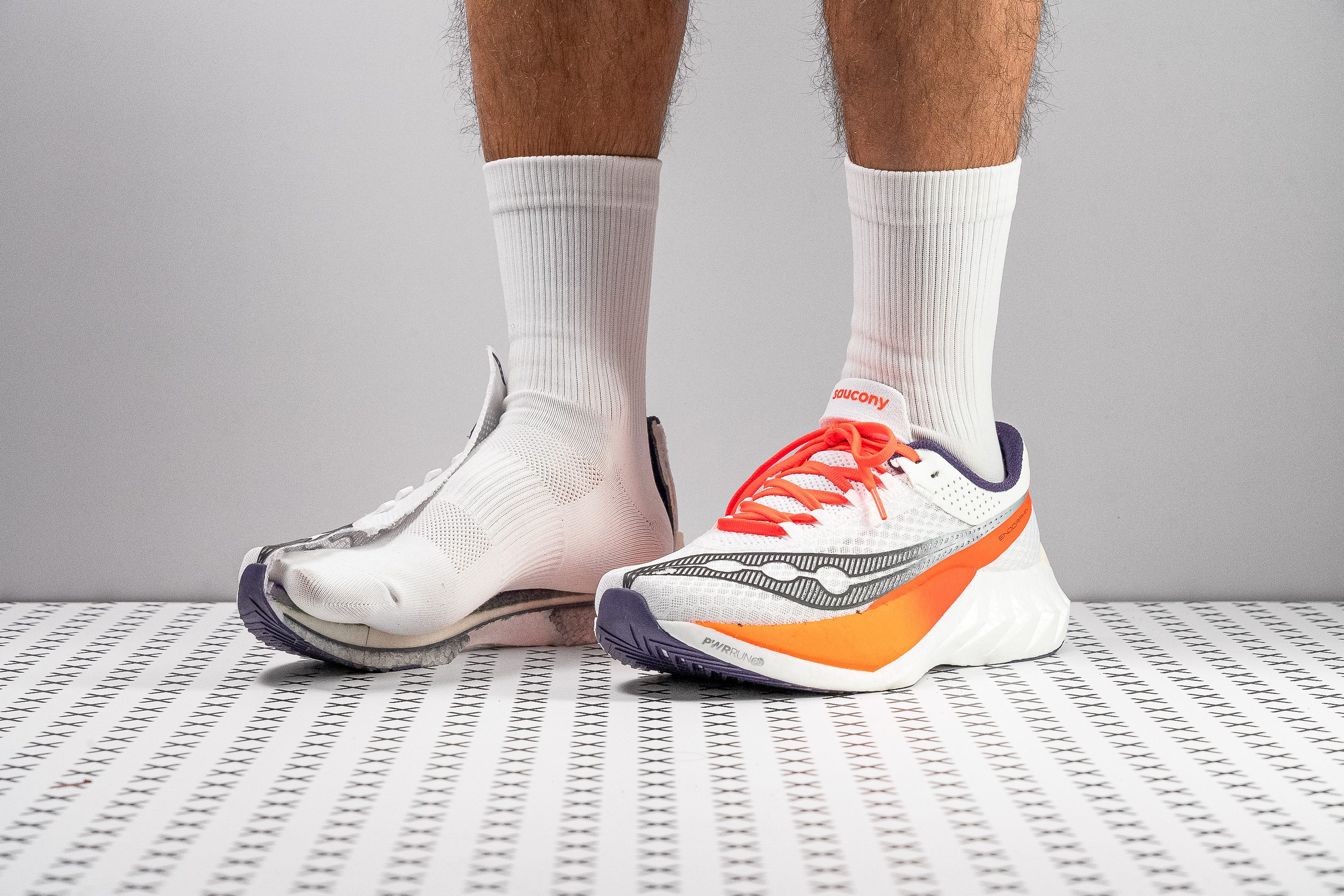


























































What makes it the best?
Massive energy rebound, heavenly cushioning, and a refreshing feel—these are just some of the many qualities that make Saucony Endorphin Pro 4 the top competition shoe for heel-strikers. Our runs feel effortless and supported by the vibrant midsole that combines comfort and speed perfectly.
At 38.1 mm, the Endorphin Pro 4 provides supreme heel cushioning for any distance. Our cut-in-half shoe reveals two distinct foams: a plush 18.5 HA top layer for protection, and a firmer 22.0 HA bottom layer for stability, ensuring confident strides even as fatigue sets in.
Embedded in the soft and bouncy midsole is the super stiff carbon plate. Our flex test reveals it needs a force that’s 71.3% higher than average to bend to 30 degrees! This translated to insane responsiveness and the feeling of being propelled forward effortlessly.
Despite all the cushioning and support, EP4 remains a featherweight 7.8 oz (220g), 17.3% lighter than the average road running shoe. The ride feels like a breath of fresh air since the upper is extremely breezy. It showcased superior performance in our breathability tests, earning a well-deserved 5/5 score. We had no worries about hotspots and blisters and could purely focus on our performance.
Although this racer is very responsive, other elite counterparts may feel faster since they focus more on speed and performance than comfort.
Pros
- Durable upper and outsole
- Spacious upper fit
- Enhanced midsole comfort
- Great value at $225 for a supershoe
- Versatile across all paces
- Ideal for heel strikers
- More stable than ever
Cons
- Slightly heavier than v3
- Less suited for forefoot strikers
- Competitors may feel quicker
Competition running shoes with the best value for money
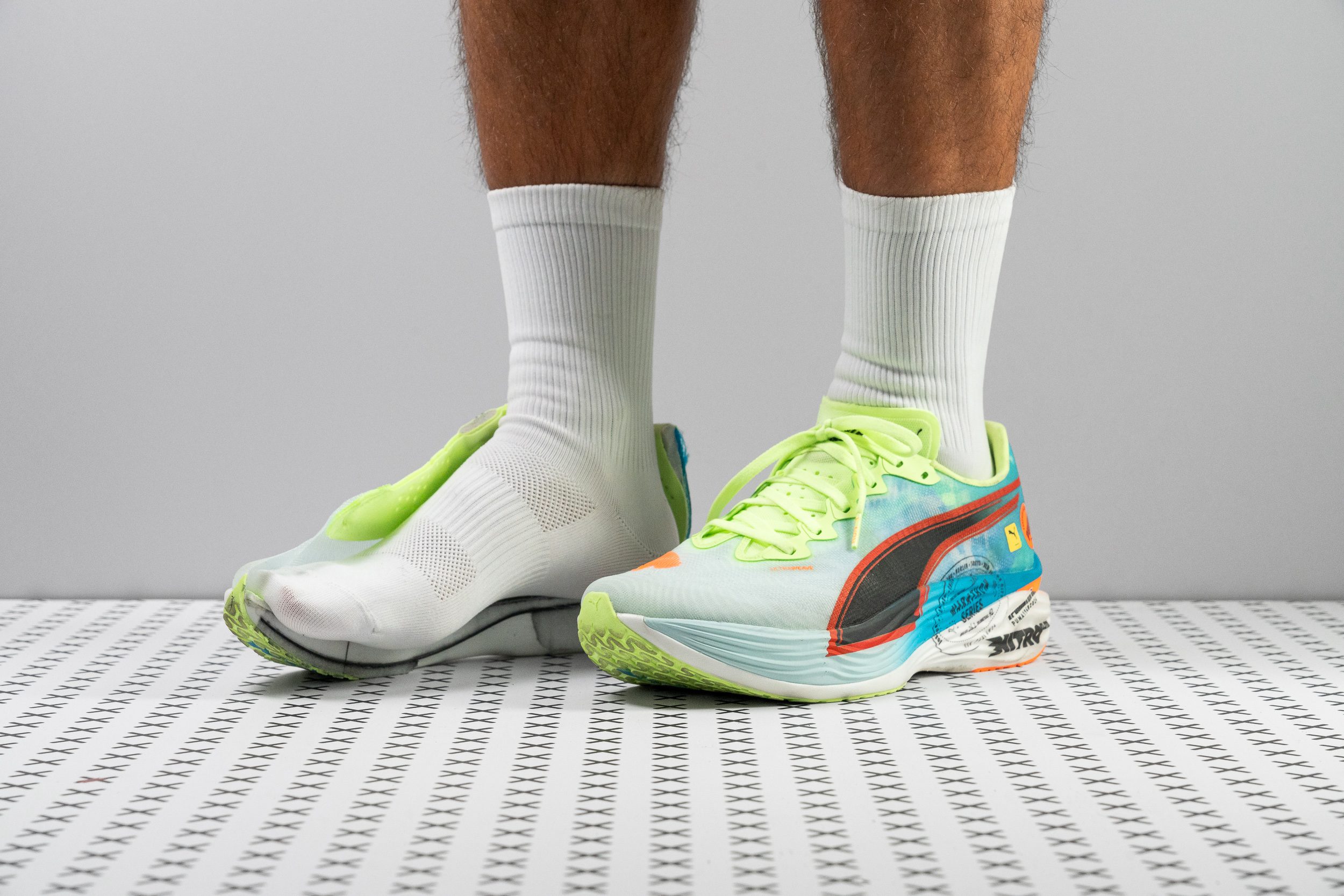
































































What makes it the best?
Among the competition running shoes we’ve tested, the PUMA Deviate Nitro Elite 3 stands out with the best value because of its exceptional build, superior foam, and explosive nature. At £230, it’s reasonably priced given the record-breaking speed it delivers that’s comparable to more expensive racers in our lab.
This shoe is elite in power and speed, launching us forward with its stiff carbon plate and rocker structure. Its light 7.2 oz (240g) build makes each turnover feel smoother, while each toe-off is delivered with exceptional energy return. Our flex test confirms it’s 78.5% stiffer than average, translating to responsiveness in our runs.
What keeps us going faster and faster is the cutting-edge Nitro Elite foam, infusing our strides with remarkable bounce. Complementing the fast-paced action is a plush 15.1 HA foam that catches our feet, and a balanced 18.3 HA base layer to stabilise our landings.
The PumaGrip’s adhesive power is unmatched and avoids any slips even through fast corners. However, its soft 72.6 HC rubber makes it more vulnerable to wear and tear. We recommend saving this shoe for racing to prolong its lifespan.
Pros
- Superb Nitro Elite foam
- Breathable, lightweight upper
- Extremely responsive
- More affordable than most supershoes
- Outstanding grip
- Great comfort for a racer
- Major improvements from v2
- Fast, agile, race-ready performance
- Fantastic tongue
Cons
- Not the best for heel strikers
- Durability concerns
- Lacks stability for some runners
Picture this.
You’re running.
You’re giving it your everything.
You’re pushing and you want that new personal best, but your legs are getting tired and you feel like you’re shoes are working against you.
The midsole is soft but not good soft.
There’s a lace bite and it’s hurting your instep.
You want to push harder but you just... Can’t.
Welcome to the crew of people who chose bad race-day shoes.
Now, let’s fix that.
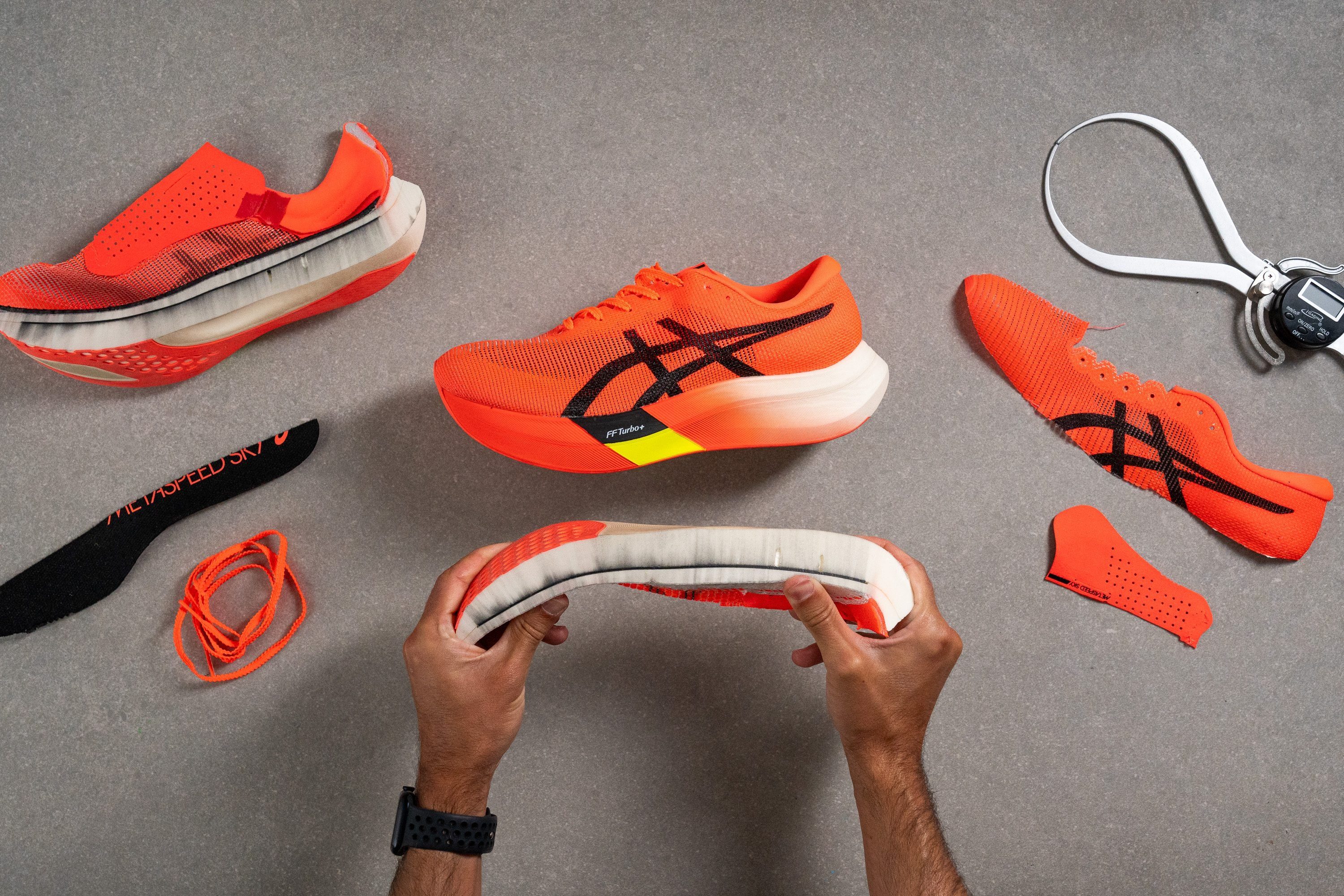
4 features of competition running shoes
You want to run the fastest time and feel good at the same time: no blisters, no discomfort, and no premature leg fatigue. Of course! Here’s what we look for in competition running shoes:
- Responsiveness! It’s a must. This means that the shoe propels you forward, the foam is not dull, you don’t need to work extra to bounce off.
- Lightweight or featherlight category of shoes. The lighter the shoes, the faster we are!
- Good shock absorption: at least 105 SA for shorter distances like 5K and 10K, at least 120 SA for a half-marathon, and 130+ SA for a marathon.
- Stable platform, especially if you’re a heel striker
- New technologies: rockers, carbon plates of different shapes and sizes combined with new foam compounds, see-through uppers, premium insoles, and so on.
We will explain each of these features below, along with the lab tests we did to test them out and more features that we had to understand along the way.
What you can expect from race-day shoes
Based on the features mentioned above, this is what you can expect from race shoes:
- Soft yet stiff platform, especially in shoes with carbon-fibre plates
- They are very cushioned
- Very breathable uppers
- Not a lot of cosy details like thick tongue padding, heel collar padding, or heel tabs because they all add unnecessary weight
- They feel and are very lightweight
- Often, the chunks of the midsoles are cut out to save weight
- Thin rubber that often does not cover the whole outsole surface to save weight
- They are not durable which is why they should be saved for the race day
- They are expensive.
Of course, there are and always will be some outliers. In this guide, we focus on average runners and what works in most cases. You will see people finishing a marathon in Asics Gel Kayano 31 which is a stability daily trainer, or in a minimalist-almost-barefoot Merrell Vapour Glove 6 with almost no cushioning and definitely no fancy tech.
While it is possible to do such things, new PBs are not achieved in non-race shoes or at least in non-tempo shoes, and if you have no extensive experience and preparation for minimalist shoes, you could end up injured.
Responsiveness: priority #1 in competition running shoes
The big mistake in finding race shoes and thinking they all work the same is not knowing the difference between standard foams and premium foams.
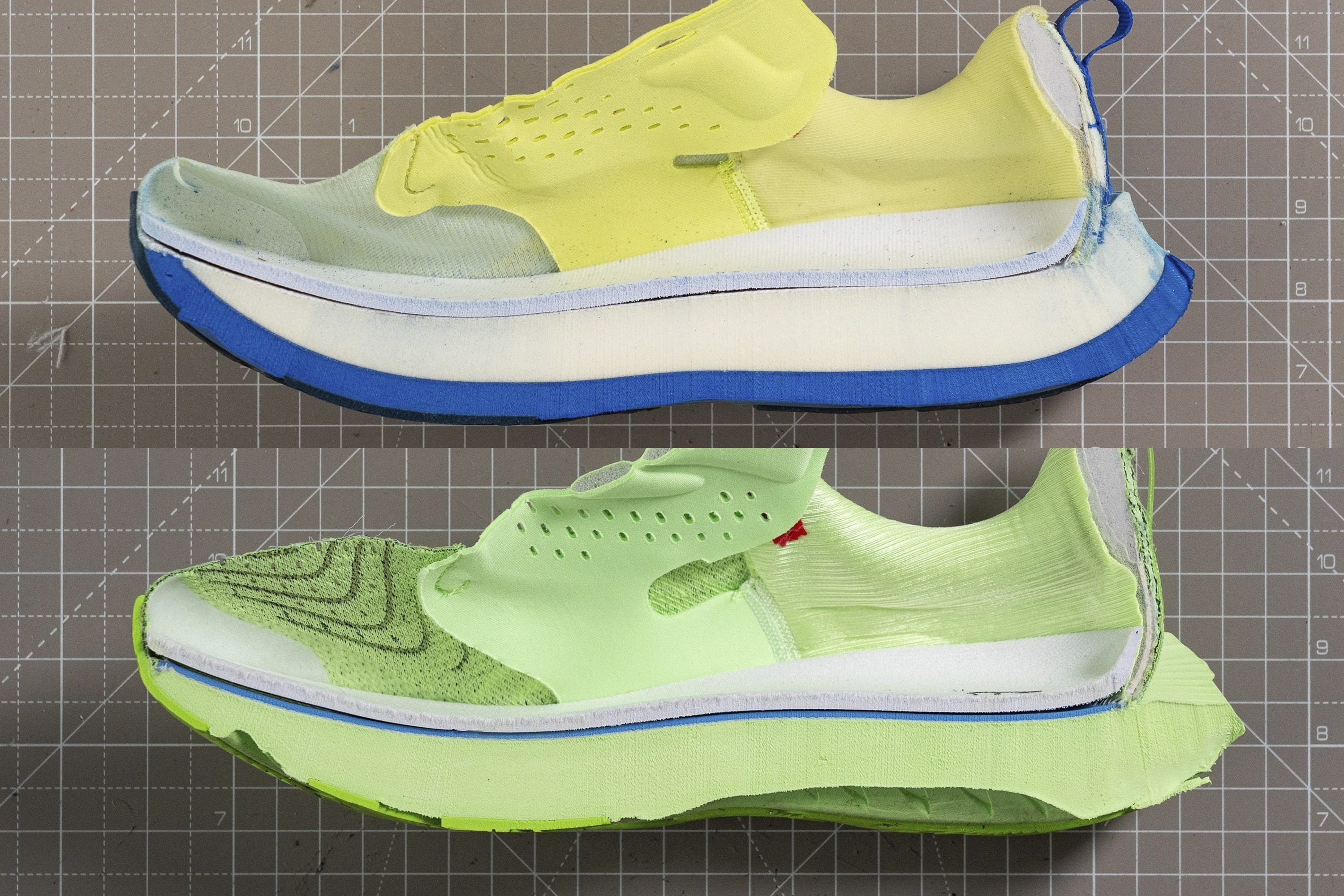
Standard foams are great for daily trainers, they are durable, affordable and they simply work. However, premium foams are what we’re looking for in competition shoes. They are insanely responsive, they have the leg-saving feature which makes us capable of running longer/harder, and they are light weight. The downside, of course, is that they are expensive and not durable. That’s why we keep race shoes for the race day.
What you want in a competition shoe: premium foam that’s maybe even paired with a carbon-fibre plate.
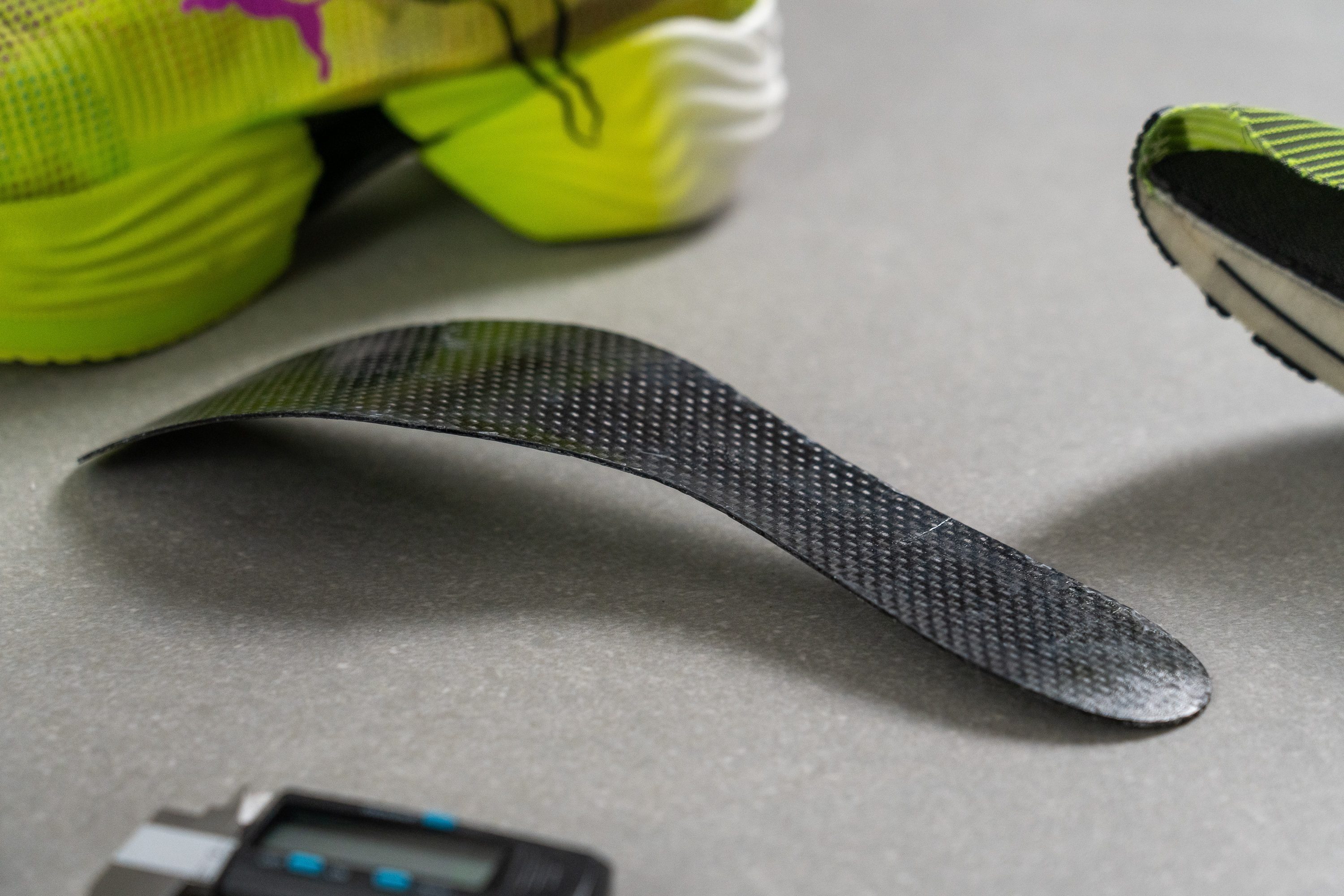
Since you can’t just look at the shoe and recognise a premium foam vs. a standard foam, it’s best look at our lab test results on energy return! Yes, this is something we test together with shock absorption, following the ASTM F1976 13 standard.
Energy return tells us how responsive the shoe is, and it is felt as a springy ride (some may even call it a trampoline effect). The higher the energy return, the better, especially in race shoes.
Energy return higher than 55% is considered moderate and higher than 65% is considered high and most often found in race shoes.
Shock absorption of competition running shoes
Many runners know that the race shoes are soft but shock absorption tells us something more valuable: how protective the midsole is or how good it is at dampening the impact forces. Every time you hit the ground, the midsole has the job to absorb that impact so that your legs are less stressed. When the midsole does this job poorly, foot pain or premature foot fatigue could happen.
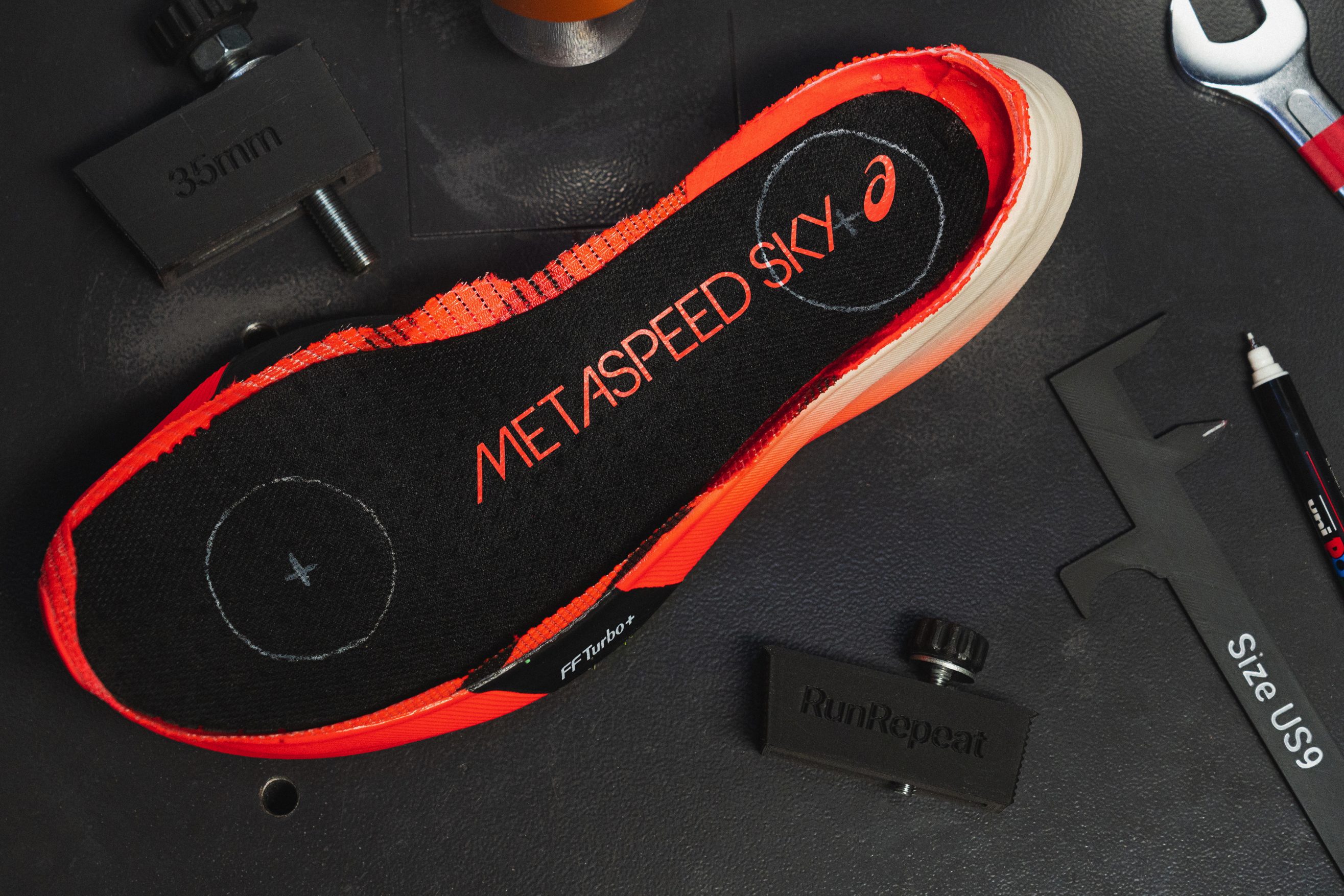
Many race shoes are made for forefoot strikers only, but knowing there are also heel strikers, we test shock absorption in both places: at 12% of the inner shoe length and at 75% of the inner shoe length. This is also where we measure the stack heights on shoes cut in half (honouring the guidelines from WorldAthletic).
How soft are competition running shoes
We’ve already said that the competition running shoes are usually soft and stiff. But just how soft are they? Let’s measure that.
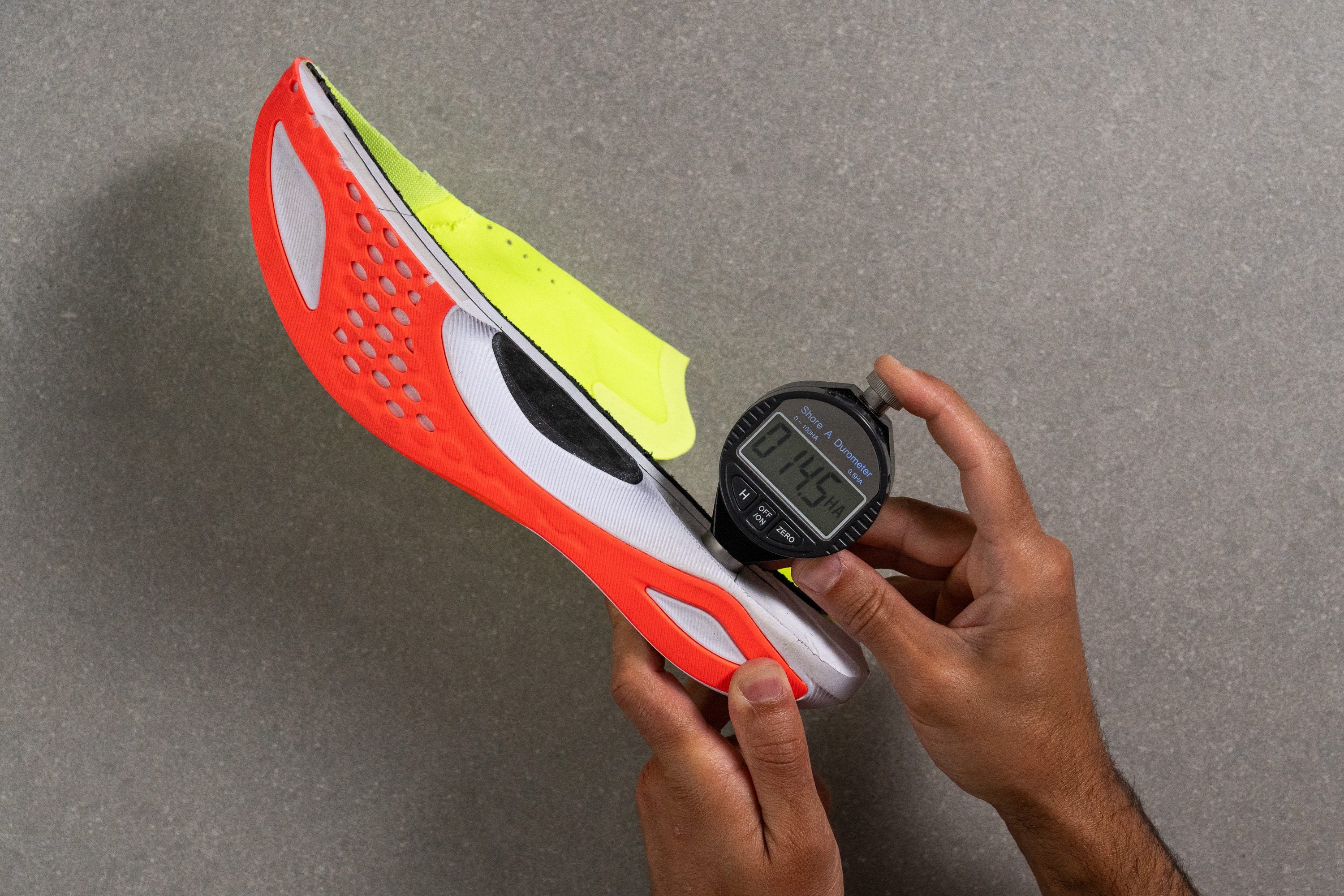
We use a shore A durometer to measure the softness of the foam. This has to be done on a shoe cut in half; otherwise, the results will be inaccurate.
The lower the number on the durometer, the softer the shoe. Based on our lab data, race shoes are 8.2% softer than daily trainers.
In case you want your race shoes to be as soft as possible, here are our top 5 softest shoes (these tables are updated automatically with every new shoe review we publish):
Stiffness of competition running shoes
It turns out that the best combination for most runners is a race shoe that is soft and stiff. We measure stiffness in our lab using a specialised machine. We lock the toebox in place and then bend the shoe to 30 degrees after adjusting for its forefoot rocker.

The more force is needed, the stiffer the shoe. Looking at all the shoes we’ve tested so far, here are the average numbers for all 3 shoe categories:
- Daily trainers: average stiffness 13.9N
- Tempo shoes: average stiffness 14.7N
- Race shoes: average stiffness 22.6N
A carbon-fibre plate plays a significant role here because it makes the shoes stiffer.
Carbon-plated competition running shoes
So, what’s the trick here? There are many shoes now that feature a carbon-fibre plate but if it’s not paired with a premium foam, the results are not as magnificent. Also, these race shoes are more expensive than the ones without a plate.
|
Stiffness and price of competition running shoes |
||
|
With a carbon plate |
Without a carbon plate |
|
|
Average weight |
7.7 oz or 217.4g |
8.1 oz or 229.0g |
|
Average price |
£240.2 |
£170.8 |
It’s important to note that carbon-plated running shoes might not work for you: a faster pace is needed to properly active the plate, some are made for forefoot/midfoot strikers only, and having an adequate weight might also play a role when it comes to experiencing all the benefits those shoes can offer.
|
We covered the topic of carbon-plated running shoe in great detail in our guide Carbon-Plated Shoes Cut In Half, Explained and Lab-Tested. |
How cushioned are competition running shoes
Cushioning (stack height) of race shoes depends on the distance, but, overall, it’s safe to go with a minimum of 30mm at the heel. Here’s what we recommend:
- For marathon: minimum of 30mm at the heel
- For half marathon: minimum of 25mm at the heel
- For 5k and 10k races: minimum of 25mm at the heel
We measure the heel stack height and forefoot stack height in our lab, honouring the guidelines from WorldAthetics. This means that we a) cut the shoe in half b) measure at the centre of the shoe c) measure the heel stack height at 12% of the inner shoe length and d) measure the forefoot stack height at 75% of the inner shoe length.
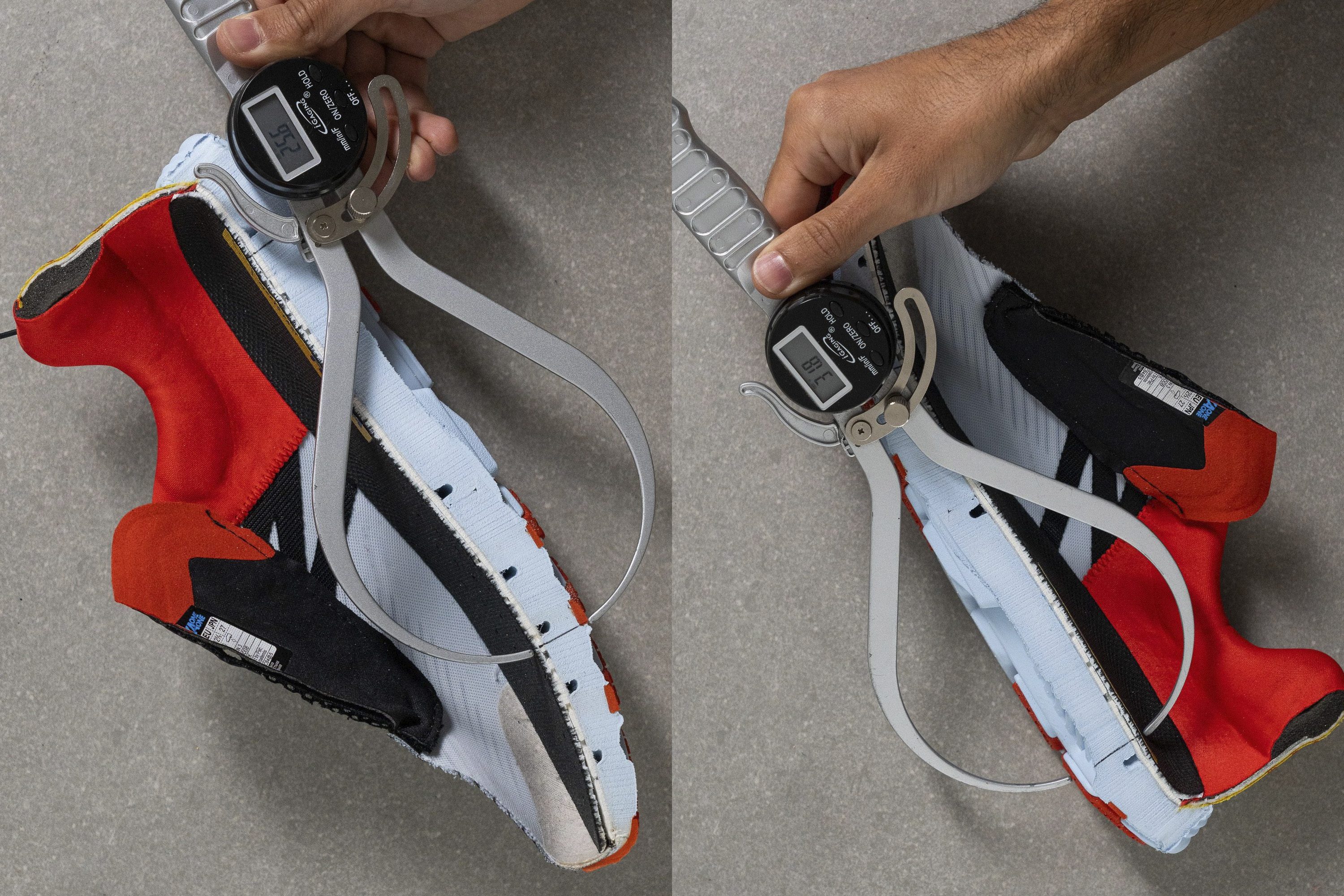
This gives us accurate numbers that often deviate from what the brands are promoting.

In case you want to go as high as possible, here are our top 5 highest competition running shoes. Just keep in mind that 40mm is the legal barrier and shoes with a higher heel stack height than that are forbidden in some races.
Stability of race day running shoes
When we talk about the height of the platform we can’t oversee the stability. If midsoles are high and narrow, they are often unstable, especially when the foam is very soft.
This brings us to the width of the platform. Yet another thing we measure in our lab.
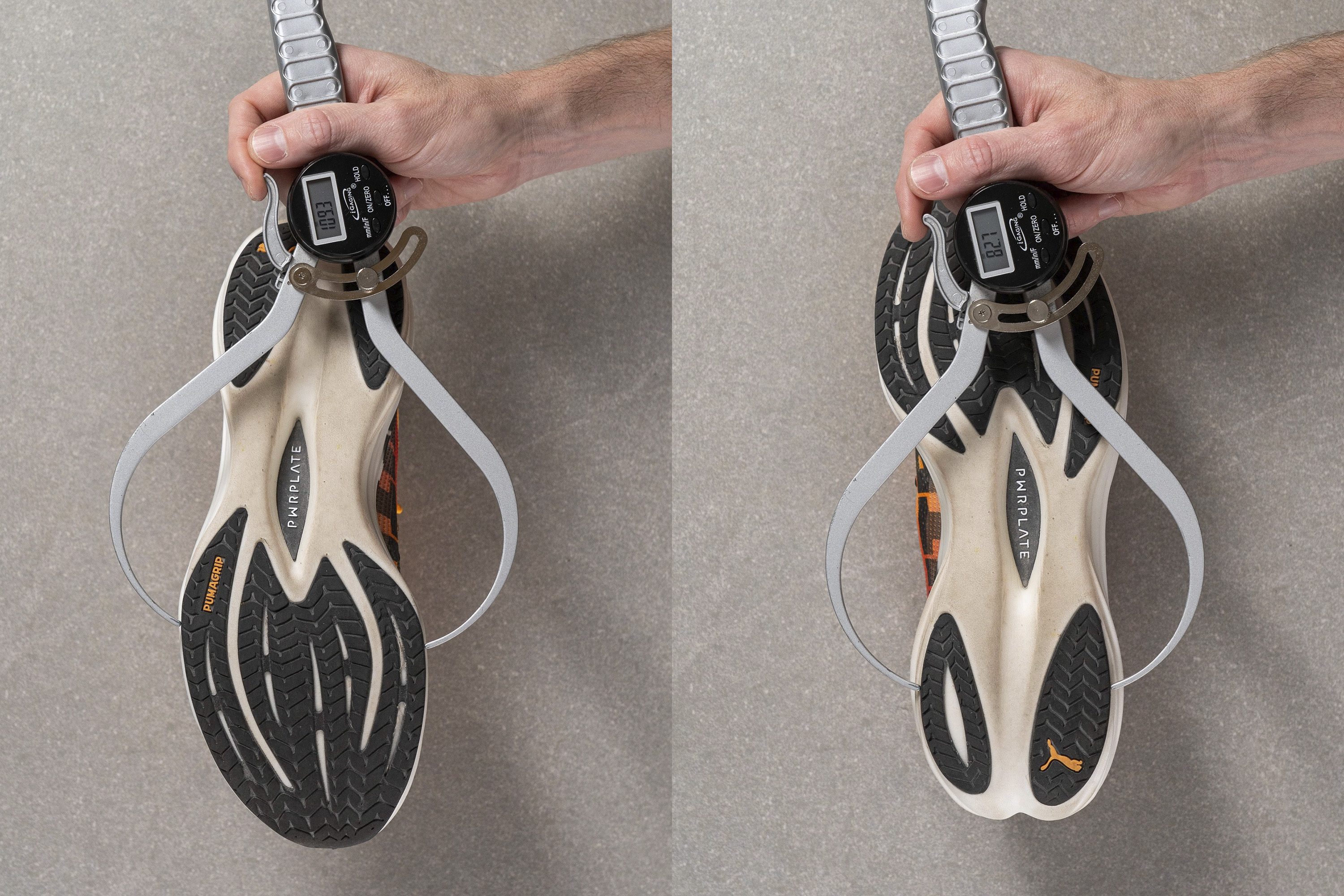
This stability is especially important if you’re a heel striker because that’s where the foam is often cut in an angle to save weight or the heel bevel is an extreme one making it not cushioned enough for heel strikers.
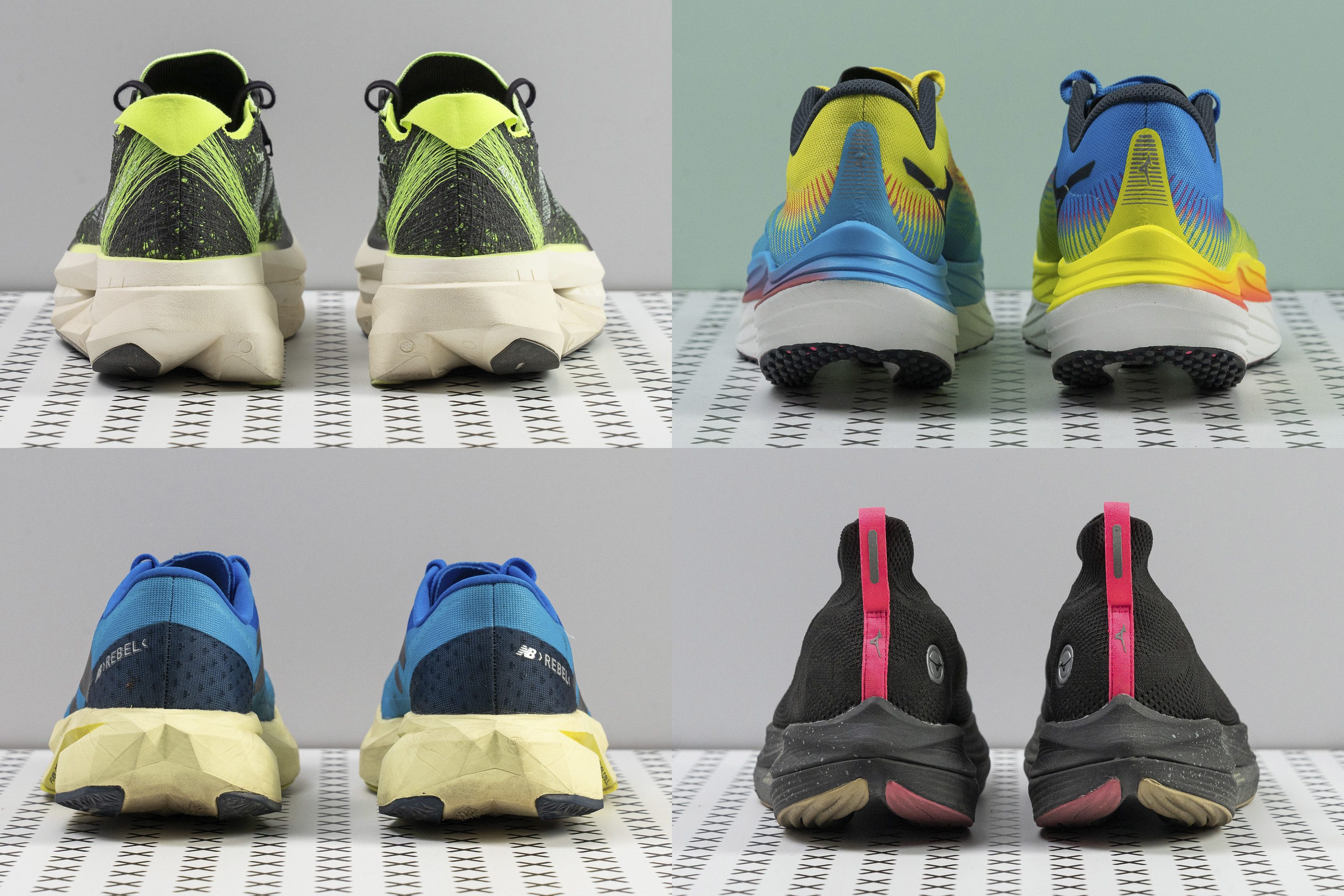
The lighter, the better!
It’s a known fact that heavy shoes can slow us down. This is why reducing the weight in race shoes is heavily prioritised. This can go as far as having:
- less midsole (chunks are cut out to save weight)
- having very thin outsoles
- avoiding comfy padding in the tongue or around the heel
- avoiding tongue gussets
- avoiding a heel tab or structural upper enforcements.
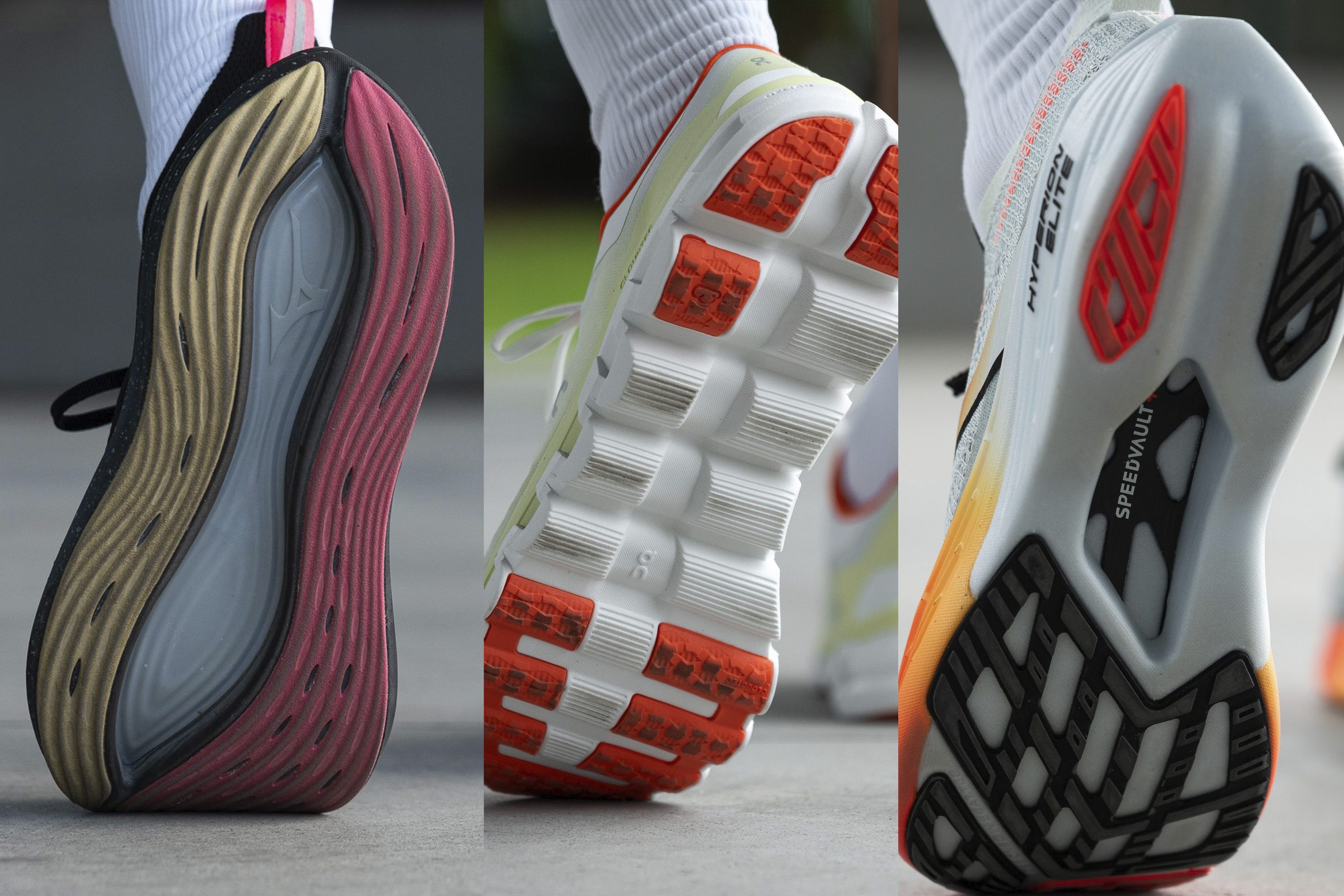


In our shoe lab, we weigh all the shoes in men’s US 9.
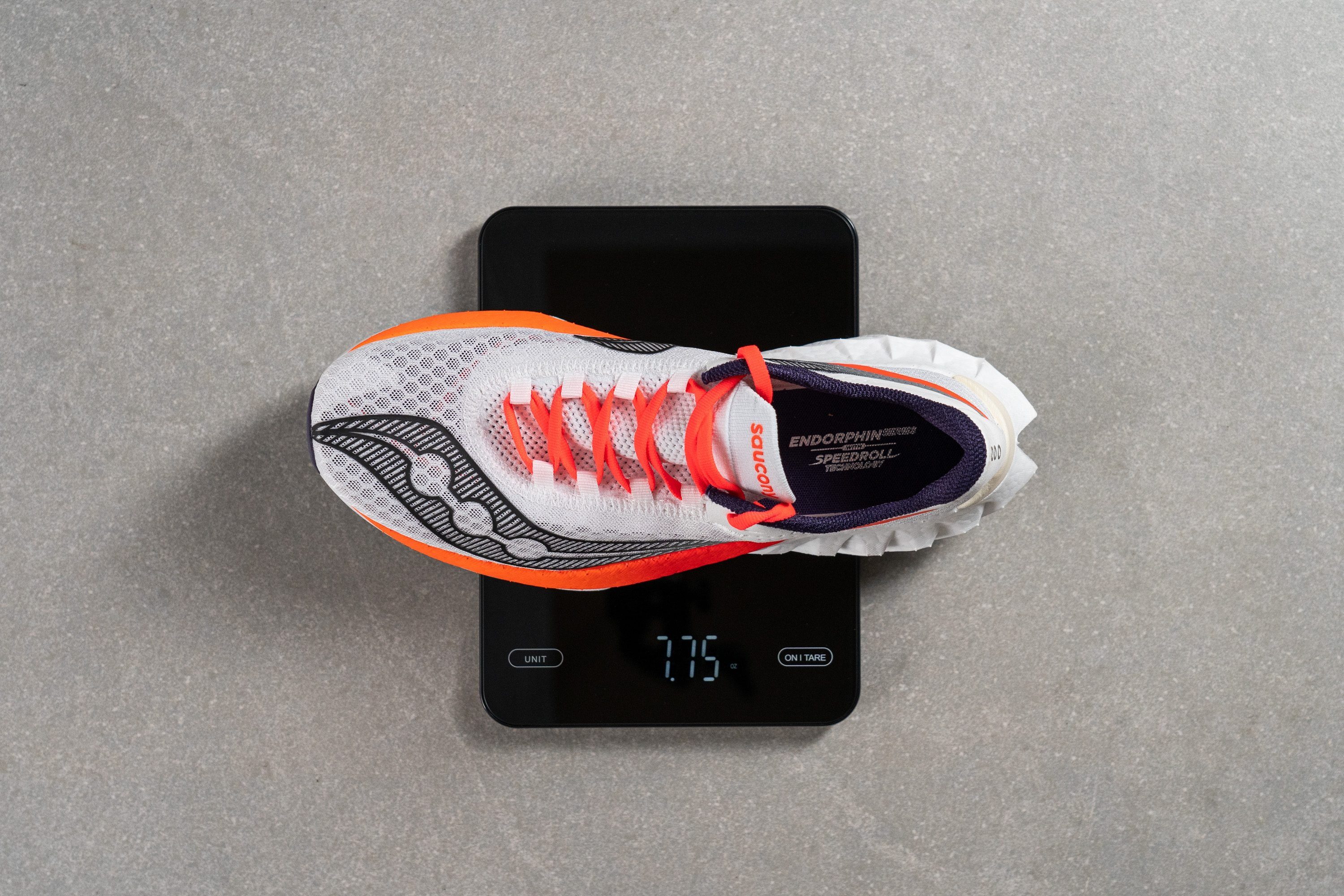
In case you want the featherlight competition running shoes, here are our top lightest picks:
Keep in mind that the weight can also depend on the distance because we need more durability for longer distances. Because of this, we use these reference points:
- Up to 270g for marathon running shoes
- Up to 270g for half marathon running shoes
- Up to 230g for 5k/10k running shoes.
Superb breathability of competition running shoes
There are 2 reasons why race-day shoes are breathable: first, because they are cutting weight so thick uppers don’t make sense, and second, because nobody wants soaked feet that would end in blisters (to start with).
We test breathability of running shoes by pumping the smoke into them. Then, we watch at the smoke that comes out: how fast does it come out? How much of it? Where exactly is it coming out - at the toebox, at the sides, or through the eyelets only? Based on this observation, we rate the breathablity of the shoe on a 1-5 scale, where 5 is the most breathable and 1 the least.
|
Shoe type |
Average breathability |
|
Daily trainers |
3.6/5.0 |
|
Tempo shoes |
4.3/5.0 |
|
Race shoes |
4.7/5.0 |
We don’t stop there, so we also look at the uppers under our microscope.
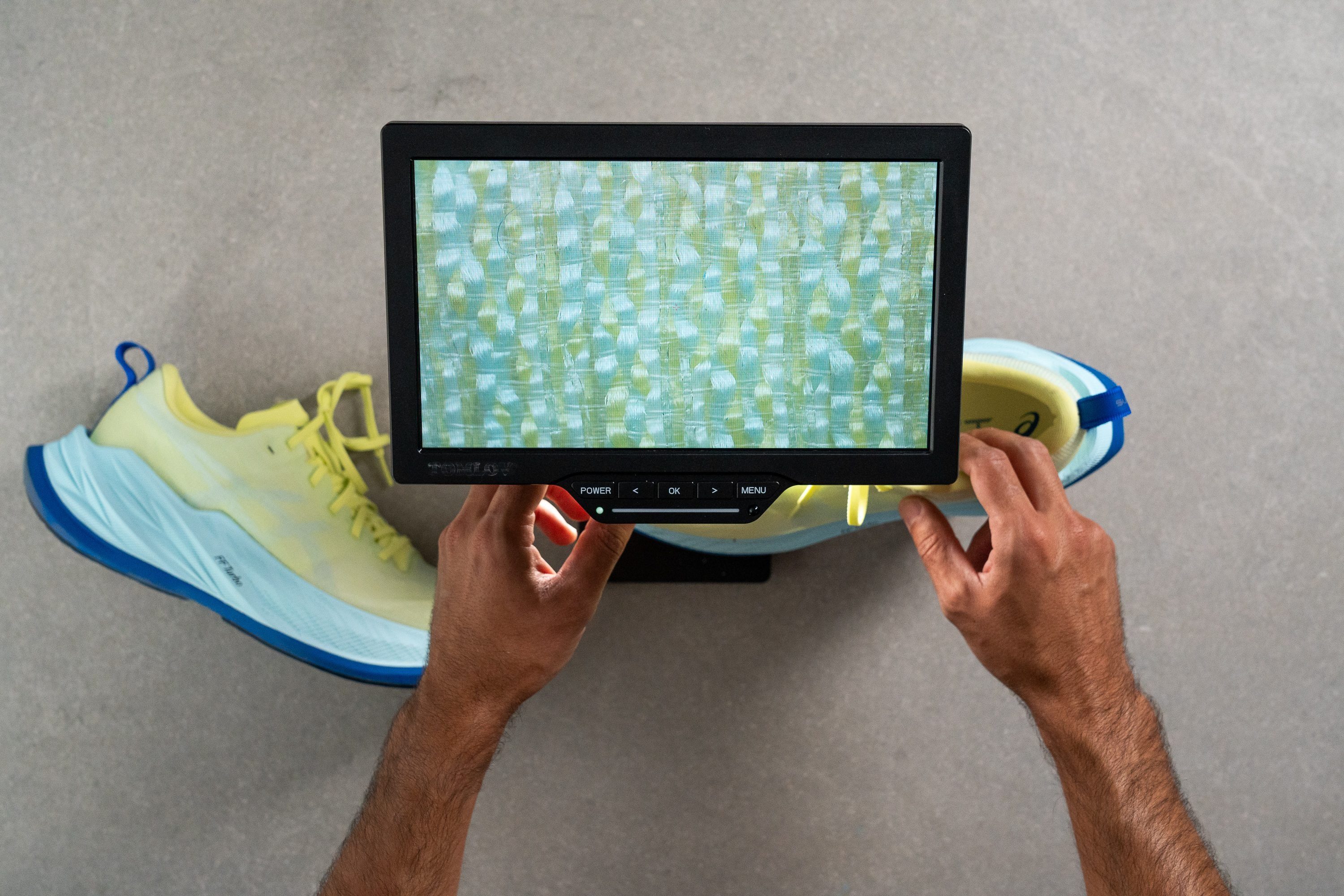
This allows us to understand better what’s happening, why the smoke isn’t coming through the upper in some places and why it’s sometimes flowing out as if nothing’s stopping it.

Rocker: a highly wanted feature in race shoes
Many runners look for a rocker in competition shoes. While having a geometry that mimicks a rocking chair sounds great, it is not recommended for everyone.
|
Rockered shoes can help if you… |
Best to avoid rockered shoes if you… |
|
Have heel, toe, or forefoot pain |
Have hip issues (bursitis, flexor strain) |
|
Have Achilles tendon issues |
Experienced ITBS |
|
Have reduced big toe extension (can’t lift it up separately from the other toes) |
Have knee issues (runner’s knee, meniscus tears, jumper’s knee) |
|
Experience calf or hamstring discomfort often |
In the lab, we put the shoe against an L-shaped ruler which allows us to see how big of an angle the forefoot rocker has in each shoe.

| If you’re a fan of this technology, here are the best competition shoes with a rocker. Also, we highly recommend our in-depth guide All you need to know about rockered running shoes. |
Outsoles: foot strike and durability
What does foot strike have to do with outsoles? Well, some competition running shoes are made for forefoot strikers. This does not mean that they don’t work at all for heel strikers, but if you look at the rubber placement, it is obvious that forefoot/midfoot strikers were favoured.

It’s important to keep this in mind because of the a) grip needed to run safely and b) durability. The exposed midsole is not grippy; it just slides over wet surfaces, and it is not durable at all.
To test the durability of the outsole, we press our dremel against it. We have standardised this test, we always use the same pressure, RPMs and the same time duration.

What helps here is having more rubber to go through before you reach the midsole. This means more time for wear and tear. To check this as well, we use a digital calliper to measure the thickness of the rubber.
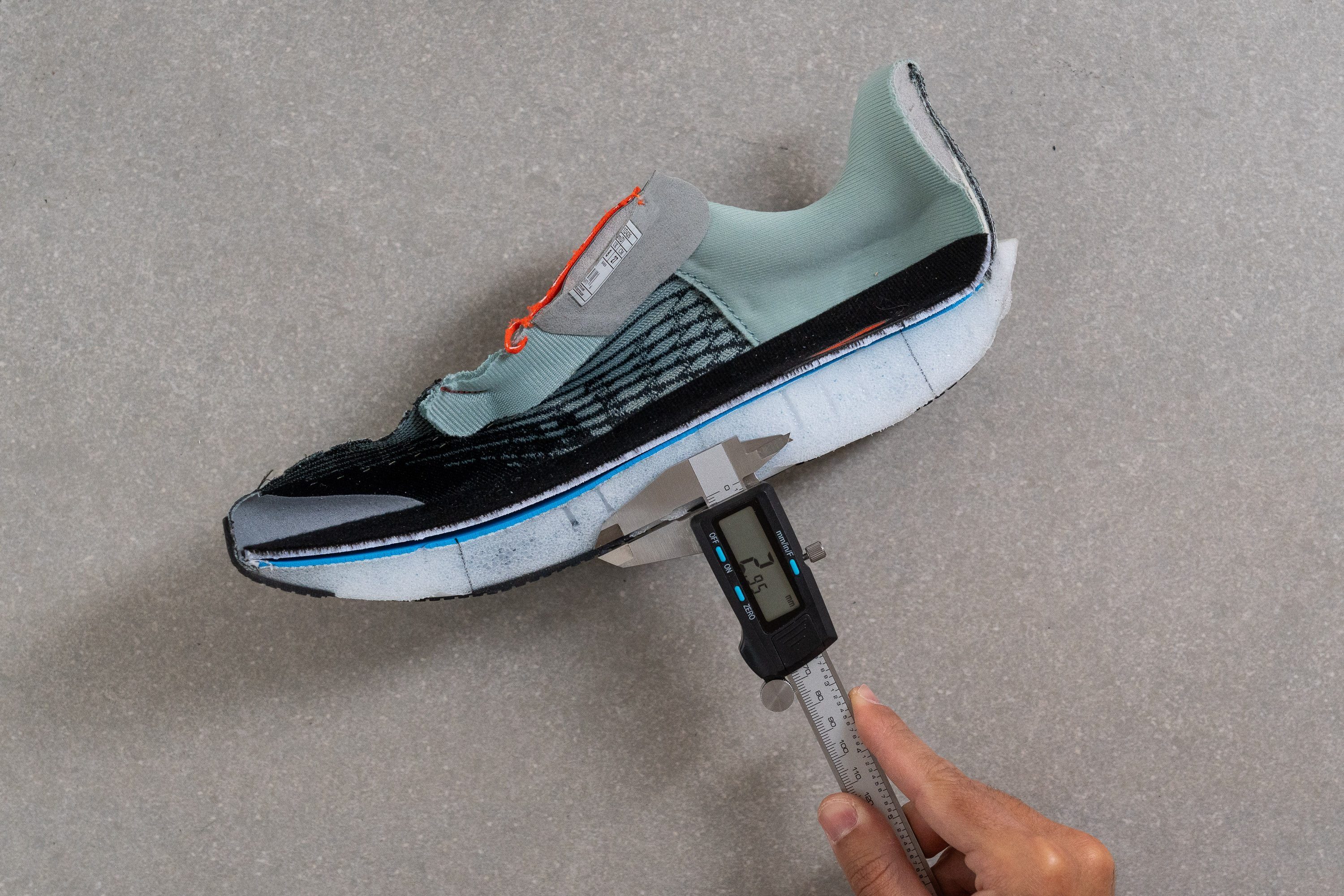
Traction in competition running shoes
To properly test traction in running shoes, we got a specialised machine that allows us to perform tests following the SATRA TM144 methodology. This means that we use a 7-degree wedge to angle the shoe and we press it using a force of 500N against the wet surface.
The result is a dynamic coefficient of friction and, the higher it is, the better. Especially if you plan to run in wet weather, for which we recommend a coefficient of traction of at least 0.45. Anything between 0.25-0.45 is considered a solid option for dry weather but slipping could happen on different wet surfaces.
Dealing with a lace bite: tongue thickness
Lace bite is the pain or pressure we experience on our instep when we tighten the laces. It most often happens because the tongue is too thin.
Competition running shoes are known for lacking any extra material, including tongue padding. Many race shoes feature a very thin tongue which is why you might experience a lace bite while trying to achieve a secure lockdown.
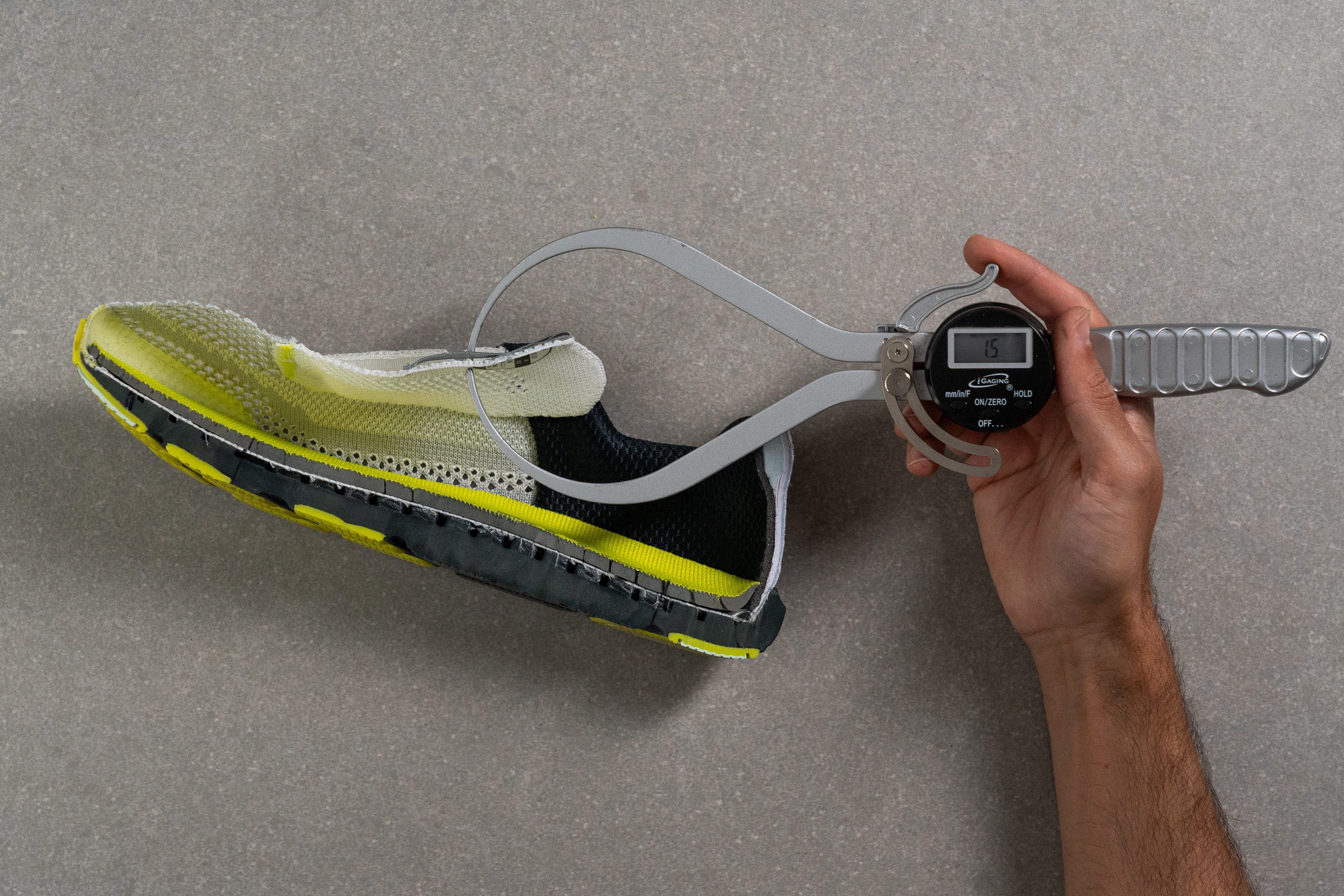
If this is your pain point, our tongue-thickness measurements come to the rescue. We always measure the thickness of the tongue so you can know in advance what to expect.
Racing in cold weather: which shoe to choose?
If you plan to race in very cold weather, we suggest choosing a shoe that
- You have already tested in cold weather and are happy with its performance
- Does not change its properties significantly when tested in cold weather.
When it comes to the bullet #1, that’s on you. When it comes to the bullet #2, it’s where we enter the scene.

We repeat 2 tests after freezing the shoe: softness and stiffness. These are the most important ones when it comes to the change in temperature and in the shoe’s performance.
| Some shoes can change their softness or stiffness significantly, but if their starting point is way below the average, they can end up being around-the-average soft or stiff post-freezing. This is why context matters. |
Below, we list the shoes that had the smallest change when comparing room-temperature results with post-freezer ones.
Can you race in tempo/speed shoes?
Of course. It’s just a matter of your goals. As mentioned above, some people finish marathons in daily trainers. However, doing a race in a speed shoe is much better than doing it in a daily trainer. Speed shoes overlap more with race shoes.

If you race in a tempo shoe instead of a competition shoe, you might miss out on that little extra, a small push that could knock off a few seconds/minutes of your finish time. This can be attributed to the reduced weight of a race shoe, cutting-edge technologies that push you forward and save your legs, and so on.
Many tempo shoes are race shoes at the same time.

